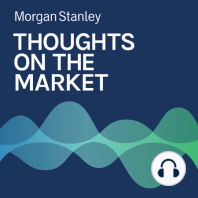3 min listen

Consumer Spending: Have Consumers Begun to Trade Down?
Consumer Spending: Have Consumers Begun to Trade Down?
ratings:
Length:
6 minutes
Released:
Aug 12, 2022
Format:
Podcast episode
Description
As inflation persists, economic concerns such as recession rise, and consumer spending patterns begin to shift, is there any evidence to suggest consumers are already trading down to value and discount products? U.S. Softlines Analyst Kimberly Greenberger and Hardlines, Broadlines and Food Retail Analyst Simeon Gutman discuss.-----Transcript-----Kimberly Greenberger: Welcome to Thoughts on the Market. I'm Kimberly Greenberger, Morgan Stanley's U.S. Softlines Analyst. Simeon Gutman: And I'm Simeon Gutman, Hardlines, Broadlines and Food Retail Analyst. Kimberly Greenberger: And on this special episode of Thoughts on the Market, we'll be discussing shifting consumer spending patterns amid persistent inflation and concerns about the economy. It's Friday, August 12th, at 11 a.m. in New York. Kimberly Greenberger: As our listeners are no doubt aware, many retail segments were big pandemic beneficiaries with record sales growth and margins for 2+ years. But now that spending on goods is normalizing from high levels and consumers are facing record high inflation and worrying about a potential recession, we're starting to see signs of what's called "trade down", which is a consumer migration from more expensive products to value priced products. So Simeon, in your broad coverage, are you seeing any evidence that consumers are trading down already? Simeon Gutman: We're seeing it in two primary ways. First, we're seeing some reversion away from durable, high ticket items away to consumable items. And the pace of consumption of some of these high ticket durable items is waning and pretty rapidly. Some of these are items that were very strong during the pandemic, electronics, some sporting goods items, home furnishings, to name a few. So these items we're seeing material sales deceleration as one form of trade down. As another in the food retail sector, we're definitely seeing signs of consumers spending less or finding ways to spend less inside the grocery store. They can do that by trading down from national brands to private brands, buying less expensive alternative, buying frozen instead of fresh and even in the meat counter, buying less expensive forms of protein. So we're seeing it manifest in those two ways. What is the situation in softlines, Kimberly? Is your coverage vulnerable to trade down risk? Kimberly Greenberger: Absolutely. In softlines retail, which is apparel, footwear, accessories retail, these are discretionary categories. Yes, there's sort of a minimum level of spending that's necessary because clothing is part of the essentials, food, shelter, clothing. But Americans' closets are full and they're full because last year there was a great deal of overspending on the apparel category. So where we have seen trade down impact our sector this year, Simeon, is we have seen consumers budget cutting and moving away from some of those more discretionary categories like apparel especially. We just have not yet seen any benefits to some of the more value oriented retailers that we would expect to see in the future if this behavior persists. Simeon Gutman: So when we're thinking about the context of our collaborative work with other Morgan Stanley sector analysts around trade down risks, what do you hear, Kimberly, about the impact on segments such as household products and restaurants? Kimberly Greenberger: We have found most fascinating, actually, the study of those real high frequency purchases. Because in order to understand how consumer behavior is changing at the margin, we think it's most important to look at what consumers were spending on last week, two weeks ago, three weeks ago as a better indication of what they're likely to spend on for the next three or six months. How that behavior has been changing is that on those of very high frequency purchases like the daily tobacco purchase or the daily food at home purchase, as you mentioned, is that there is trade down from higher priced brands and products into more value
Released:
Aug 12, 2022
Format:
Podcast episode
Titles in the series (100)
Mike Wilson: 3 Summer Surprises Investors Could Be Missing by Thoughts on the Market